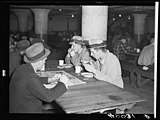Sheldon Dick
Sheldon Dick (1906–1950) was an American publisher, literary agent, polo player, photographer, and filmmaker. He is best known for the photographs he took on behalf of the Farm Security Administration during the Great Depression.
Early life
Sheldon Dick was the son of Albert Blake Dick, a wealthy manufacturer of mimeograph machines in Chicago, and Mary Henrietta Dick.[1] He married Dorothy Michelson, a 21-year-old professor's daughter, in 1927, shortly before Dick began studies at Corpus Christi College at Cambridge University.[2] On returning to the United States, the couple lived in New York; their daughter, also named Dorothy, was born shortly thereafter.
The marriage was brief. Mrs. Dick filed for divorce in April of 1932, and stated in her suit that the couple had been separated for a year. The divorce was concluded within a day, and she received custody of the child.[3]
Dick was active as a publisher at the time; the most notable volume to bear his name as an imprint was a book of poems, The Serpent in the Wilderness, by Edgar Lee Masters, published in a fine-press limited edition in 1933.[4] Dick married Mary Lee Burgess that year; she would later assist in his documentary work.
Dick was active as a photographer prior to his work with the FSA; he took photographs for a book on Mexico, published in 1935.[5] The book was not well-received, however, and a review states that "The group of photographs adds little to the volume."[6]
With the FSA
Because of his composition of images of the poor surrounded by religious items and by ordinary household objects (objects not in themselves indicating poverty), Dick's photographs are less polically clear than those of the other FSA photographers. According to one critic, Dick's composition "transgresses common assumptions about men and religion and therefore appears to be less 'documentary.'"[7]
Dick worked relatively briefly for the FSA, in 1937 and 1938. He was independently wealthy and supported himself, submitting his photographs for payment of one dollar a year.[8] During the period of his association, however, he travelled as widely and submitted as many photographs as the full time employees. Because Dick was not a full-time employee of the FSA, his travels are not well documented, but they can be inferred from the photographs he took.[9] Some of the greatest concentrations of surviving images are represented are in a few documentable trips over the year and a half of Dick's work:
-
In January and February of 1937, Dick photographed the Flint Sit-Down Strike for the FSA. Many of his photographs, like this one, are of ordinary life during the strike.
-
In July of 1938, Dick was in Baltimore, taking photographs of poor black and white neighborhoods.
-
That August, Dick took photographs of damage from the New England Hurricane of 1938 in Connecticut (where this photograph of a destroyed tobacco barn was taken) and Massachusetts.
-
A number of images exist of the Lancaster County, Pennsylvania area, dated "1938?." The description filed with this photograph includes the note, "Notice the Amish boy on the extreme left."[10]
-
Dick's images of Western Pennsylvania mining towns, including this one of a bar in Gilberton, focus on everyday activities, household living and items, and the mines themselves.
One of his most ambitious projects was a 16½-minute documentary film, narrated by the actor Will Geer, about silicosis in the mining towns surrounding Joplin, Missouri (known as the "tri-state area").[11] The film, titled Men and Dust, was released in conjunction with the Association of Documentary Film Producers in New York; Lee Dick, his wife, is co-credited.[12] His work in this area proved to be his most influential effort; the film is cited in modern scholarship on the region's history, and his photographs of the miners and their families were displayed in a New York gallery to positive reviews.[13] Film scholar William Alexander, documenting films of the American left wing, has said that Men and Dust is "affecting and powerful" through its "mind-jogging changes of stance."[14]
Death
In 1950 Dick was married to his third wife, Elizabeth Durand Dick, with whom he had three children. After stints as literary agent and polo player, he was retired and living in Greens Farms, Westport, Connecticut. Early on the morning of May 12 of that year, Dick telephoned the police and said, "We have just killed ourselves. Send an officer right away."[15] Both were dead when the police arrived; both shootings were ascribed to Dick. The New York Times reported that, "Other than the 'temporary insanity' theory advanced by [the medical examiner], investigators were unable to establish a motive for the shooting."
References
- ^ "Why S. Dick Wed Suddenly," The New York Times, September 29, 1927; "Mrs. Albert Blake Dick" (obituary), The New York Times, September 27, 1944.
- ^ "Dorothy Michelson Surprises by Wedding," The New York Times, September 29, 1927.
- ^ "Wife Sues Sheldon Dick," The New York Times, April 6, 1932;"Divorces Sheldon Dick," The New York Times, April 7, 1932.
- ^ A note on the copyright page reads, "This edition consists of 400 numbered copies, of which 365 are for sale, numbers 1 to 84 inclusive, containing holograph manuscript. The book was made under the supervision of Vrest Orton & Ray Nash, and printed at the Marchbanks press on papier de Rives in Baskerville type." Masters, Edgar Lee, The Serpent in the Wilderness (New York: S. Dick, 1933).
- ^ Mackie, Edith, and Dick, Sheldon, Mexican Journey: An Intimate Guide to Mexico (New York: Dodge Publishing Company, 1935).
- ^ Benjamin, Robert Spiers, "Mexican Journey," The New York Times, September 27, 1936.
- ^ McDannell, Colleen, Picturing Faith: Photography and the Great Depression (New Haven: Yale University Press, 2004), 40.
- ^ McDannell, 39.
- ^ McDannell makes this observation (39).
- ^ Library of Congress Prints and Photographs Archive, Call # LC-USF34-040326-D, online version http://hdl.loc.gov/loc.pnp/fsa.8c02290.
- ^ Markowitz, Gerald, and Rosner, David, "'The Street of Walking Death': Silicosis, Health, and Labor in the Tri-State Region, 1900-1950," The Journal of American History, Vol. 77, No. 2. (1990), 539.
- ^ Crowther, Bosley, "Onward March the Documentaries," The New York Times, February 4, 1940.
- ^ For the film, see Markowitz and Rosner. For the photographs, see Devree, Howard, "A Reviewer's Notebook," The New York Times, May 21, 1939. Devree said of the photographs, "These highly-moving documents [. . .] deserve a wide audience.
- ^ Alexander, Film on the Left, quoted in Booker, M. Keith, Film and the American Left: A Research Guide (Westport: Greenwood Press, 1999), 78.
- ^ "Sheldon Dick Kills Wife and Himself," The New York Times,May 13, 1950.
External links
- Photographs from the FSA at the Library of Congress. Contains records of all of Dick's photographs for the FSA and digital versions of some of them.
{{commonscat}} [[Category:1906 births|Dick, Sheldon]] [[Category:1950 deaths|Dick, Sheldon]] [[Category:American photographers|Dick, Sheldon]] [[Category:Alumni of Corpus Christi College, Cambridge|Dick, Sheldon]]




![A number of images exist of the Lancaster County, Pennsylvania area, dated "1938?." The description filed with this photograph includes the note, "Notice the Amish boy on the extreme left."[10]](/media/wikipedia/commons/thumb/3/33/Sheldon_Dick_Lancaster_school.jpg/158px-Sheldon_Dick_Lancaster_school.jpg)
